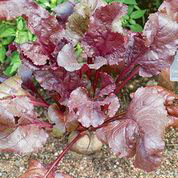

Turn that trait into a time-saver by planting multi-plant blocks. But their “seeds” are actually pods containing multiple seeds, so rows must be laboriously thinned.
#Bulls blood beet seedlings skin#
This will keep the skin from hardening over and losing its smooth, red appearance.īeets do long service in the garden, from the first snippets of spring greens to rich, flavorful storage beets in winter. If you’re planning to serve your tender baby Beets whole and unpeeled, try hilling the soil around their shoulders as they grow. Tips for Harvesting and Storing Root Vegetables Steamed and dressed with butter and lemon juice. Them whole with other root vegetables for hearty Larger for winter storage.) Enjoy chilled, with goatĬheese, black olives and dried cranberries over baby Harvest them on the smaller side to enjoy their The soil has warmed to at least 45☏ and there is noĬhance of hard frost. Stunting and bolting (going to seed), so wait until Soaking the Beet seeds for an hour in bathtubwarm Big yum.) Deer resistant.īeets grow from compound seeds, which may (Don't forget to roast extra Beets and serve them sliced and chilled over baby greens with crumbled goat cheese, toasted pine nuts, finely diced scallions and a raspberry vinaigrette. (Check them every once in a while to see how they are doing.) Roast whole Beets in the oven to retain their rich flavor for special, more hearty fare. You can dig them out like treasure for up to four months or so.

Store in a cool (33☏ to 39☏), humid spot like a root cellar or insulated garage. In a breathable container (wooden box), spread a layer of sterile sand, lay down a layer of Beets, continuing these layers to the top.

Trim the greens, retain the taproots and allow surface moisture to dry. Want to store long-keeping Beets like a pioneer? Select the best unblemished Beets. Beet tops, or greens, are good too eaten together with Beets, they ensure a dinner rich in vitamins and minerals. Young, tender Beets make the best eating whether they are grated raw in salads, steamed and chilled, or roasted. Over harvesting greens will inhibit root growth.īeet roots can be canned or frozen for longterm storage.Direct-sow Beet seeds as soon as the soil can be worked in the spring when the soil has warmed to about 50☏ and through the summer for successive crops. When harvesting beets waiting until they have reached maturity at 2” – 3”, about 60 days.īeet root is at its nutritional highest when harvested young. When eating the dark-purplish-red leaves, best when harvested young and tender, approximately 35 days. Plant in 2-3 week intervals for successive harvesting. They do not want their roots disrupted and want to be able to send them down as soon as they are planted. Seeds should be directly sown into the soil. Keep soil evenly moist while seeds are germinating. Days to Maturity: 30 days for greens, 55 days for roots.In Sweden, red food color may only be produced from this cultivar.īeets are a great source of vitamin A, thiamine, and vitamin C. At the time what we know as a beet was known as a blood turnip, up till the late 1880’s. In the historical sense, beets are a relatively new vegetable, where no records have been found prior to the 1600’s. When pickling, best to use early, when young. The bulls blood can be ideally boiled, pickled, baked, canned or frozen. Beets are delicious in a wide range of recipes from raw extravagant dishes of shaved beets in salad, raw soup, shakes and juices. Known to be tolerant of the cold and the heat, this versatile vegetable is commonly found as ornamental around a garden bed and border. This heirloom is known for its 2” – 3” size and 18” height as well as its remarkable diversity in use, taste and texture. When sliced it reveals a cross section of beautiful white zoning rings. The young tender leaves offer an incredible juxtaposition in color and flavor to any mesclun salad while the meat of this vegetable enriches dishes with its sweetness in taste and richness in color. Specially selected, from the French variety Crapaudine, by seedman Kees Sahin in the Netherlands for is characteristic deep dark colored leaves. Bulls blood is a beautiful and delicious edible ornamental providing visual and culinary delight! This heirloom beet originated in 1840 and has been recognized for its deep burgundy flesh, stem and leaves, all of which are edible and infamous for.


 0 kommentar(er)
0 kommentar(er)
